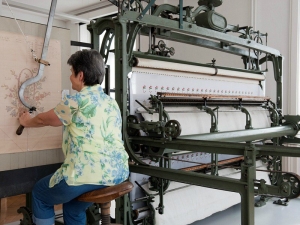Basically, Heilmann’s hand-embroidery machine used a pantograph system to transfer the stitches. Each stitch is drawn out on a large-scale design and then its position traced by an operator using a point on one arm of the pantograph. A series of needles responds to the movement of the pantograph arm. Each needle has an eye in the middle for the thread, and two sharp ends. The needle is passed backwards and forwards through the ground cloth using a pincer system (double-sided pincer wagons), so imitating the action and appearance of hand embroidery.
Each colour in the design is individually stitched (so all the blue parts, for example, are worked, and then the machine is re-threaded with a new colour), until the design is complete. This machine, in various sizes, was used in both domestic and factory settings.
Based on surviving examples, it would appear that wide strips (domestic) and very broad sheets (factory), both of organza cloth were embroidered. Using hand-embroidery machines it was possible to produce hundreds of images on a sheet in one go. It should be noted that these early machines could use floss silk threads, while the Schiffli embroidery machine required a spun/twisted thread.
This type of machine was used to make a type of postcard that was very popular in the first half of the twentieth century, namely the silk embroidered postcards. These were posted in their millions, especially during the First World War (1914-1918).
Sources:
- COLLINS, Ian (2001). An Illustrated History of the Embroidered Silk Postcard, Radlett: Gabrian Antiques.
- STROBEL, Heino (2012). The Beginnings of Machine Embroidery in Saxony, available here (retrieved 25 October 2015).
- WANNER, Anne (2013). 'Technikgeschichte der Kettenstichmaschine und Hinweise zu Stickereiindustrie und Maschinenstickerei,' available here (retrieved 9th July 2016).
Digital source (retrieved 8th July 2016).
See also Museum Schaustickerei, Plauen.
Videos showing early hand-embroidery machines in use:
- http://youtu.be/g9n1CYs9MaM (retrieved 4th April 2016).
- http://youtu.be/a5ZYZsFnhNU (retrieved 4th April 2016).
- http://youtu.be/_vYCMz-M2zs (retrieved 4th April 2016).
Digital source of illustration (retrieved 20th May 2017).
GVE

